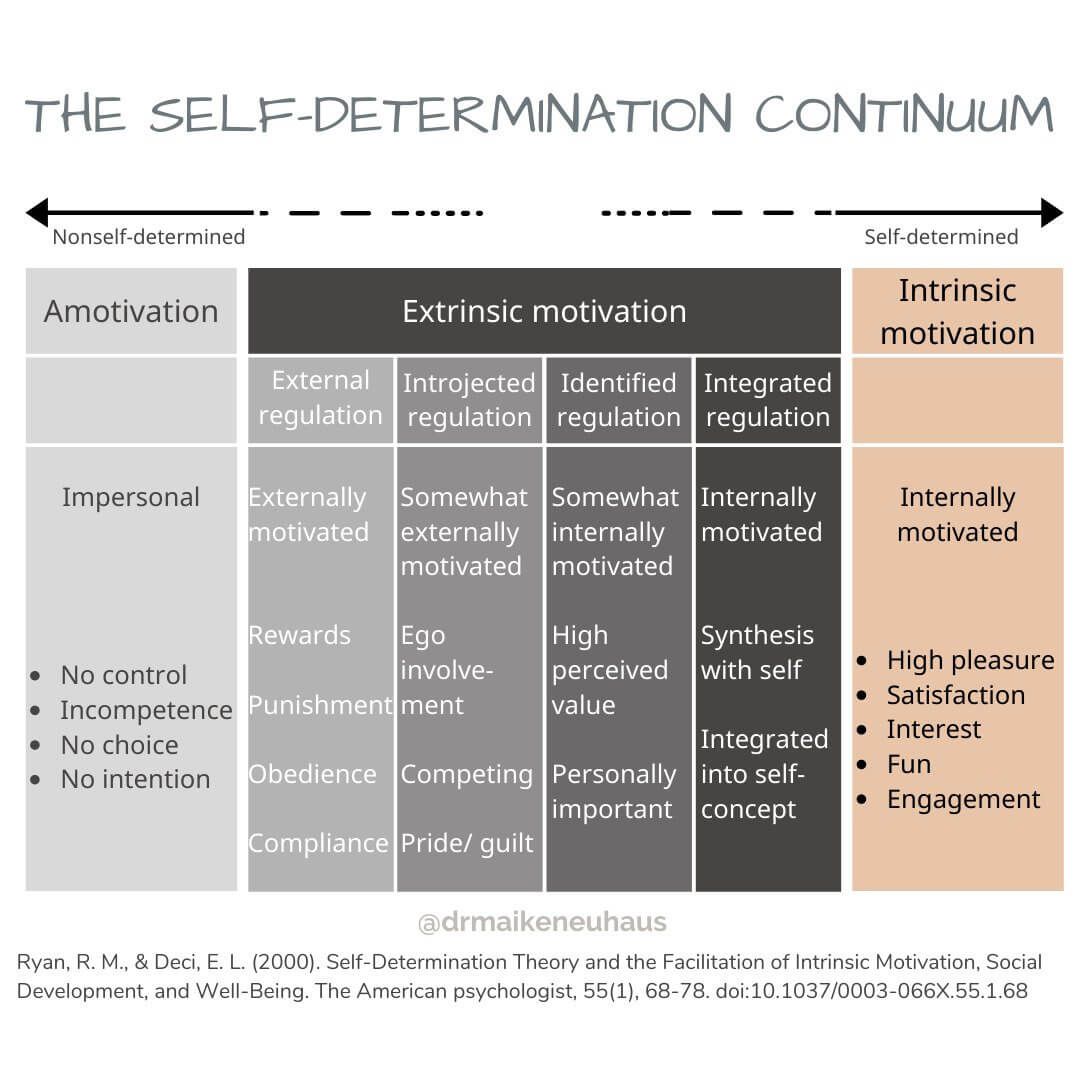Intrinsic Motivation Explained: 10 Examples & Key Factors

“Perhaps no single phenomenon reflects the positive potential of human nature as much as intrinsic motivation, the inherent tendency to seek out novelty and challenges, to extend and exercise one’s capacities, to explore, and to learn” (Ryan & Deci, 2000, p. 3).
When we do something we love doing, we are like an engine that does not require any fuel. For some, that is running marathons; for others, it is solving math puzzles or graphic design.
The increasing knowledge and awareness about intrinsic motivation is also the reason why extrinsic motivators, such as financial incentives, have been perceived slightly less favorably in recent years.
But is intrinsic motivation truly as good as it is made out to be? Is it true that it is exclusively determined by birth, or can we shape it? And are extrinsic motivators as detrimental to our drive as they seem?
This article will provide some answers to these questions.
Before you continue, we thought you might like to download our three Goal Achievement Exercises for free. These detailed, science-based exercises will help you or your clients create actionable goals and master techniques to create lasting behavior change.
This Article Contains:
- What Is Intrinsic Motivation?
- Self-Determination Theory Explained
- Intrinsic Motivation vs Extrinsic Motivation
- 4 Relatable Examples
- 6 Factors That Promote Intrinsic Motivation
- 15 Benefits of Intrinsic Motivation
- Is It Better Than Extrinsic Motivation?
- A Look at the Research
- PositivePsychology.com’s Helpful Resources
- A Take-Home Message
- References
What Is Intrinsic Motivation?
Motivation is the force behind human performance. It can arise from physiological or psychological needs, thoughts, or emotions (Baumeister, 2016). Our physiological needs help us preserve optimal physical functioning, while psychological needs typically help us thrive.
The source of motivation can come from within ourselves (i.e., intrinsic) or be external to us (i.e., extrinsic).
The American Psychological Association defines intrinsic motivation as “an incentive to engage in a specific activity that derives from pleasure in the activity itself (e.g., a genuine interest in a subject studied) rather than because of any external benefits that might be obtained (e.g., money, course credits)” (Intrinsic motivation, n.d.).
So, we are intrinsically motivated when we do something just because we want to do it and because the act of doing it provides us with a feeling of pleasure, based on our natural interests, values, and passions.
Tasks that are intrinsically motivating are also referred to as ‘autotelic tasks’ (Csikszentmihalyi, 1990). Autotelic tasks have the potential to lift us into a state of flow, marked by deep engagement, energized focus, and a warped sense of time. Mihaly Csikszentmihalyi recognized the significance of ‘flow’ and coined the term accordingly.
“The autotelic experience, or flow, lifts the course of life to a different level. Alienation gives way to involvement, enjoyment replaces boredom, helplessness turns into a feeling of control, and psychic energy works to reinforce the sense of self, instead of being lost in the service of external goals. When experience is intrinsically rewarding life is justified in the present, instead of being held hostage to a hypothetical future gain.”
Csikszentmihalyi, 1990, p. 69
Dan Pink has given this interesting TED talk about intrinsic motivation.
It is impossible to study intrinsic motivation without considering the research done by Richard Ryan and Edward Deci.
These researchers spent decades advancing our knowledge about intrinsic and extrinsic motivation and developed what is possibly the most widely accepted motivational theory to date: Self-Determination Theory (Ryan & Deci, 2000).
Self-Determination Theory Explained

The theory is concerned with the “interplay between the extrinsic forces acting on persons and the intrinsic motives and needs inherent in human nature” (Center for Self-Determination Theory, n.d.).
At the core of the theory lies the innate motivation for people to grow, similar to the highest, self-actualization level in Maslow’s (1943) famous hierarchy of needs.
This motivation is determined by three essential, inborn, psychological human needs that motivate performance: autonomy, competence, and relatedness (Ryan & Deci, 2000).
- Autonomy refers to our willingness, volition, or perceived control over what we do. It involves how much say we have over when and how we do something, and how much we want to do something rather than have to do it.
- Competence pertains to how much our action aligns with our capabilities, such as our knowledge and skills. We need to feel capable of achieving the desired outcome. However, in order to achieve an optimal level of engagement, the activity must not be too easy, either.
- Relatedness is the level of feeling cared for and connected to others. It is the degree of meaning we derive from an activity, the sense of connectedness to others it brings us, and if it is aligned with a purpose bigger than ourselves. Relatedness is also sometimes referred to as ‘belonging.’ So, if you come across a source inviting you to develop an ‘ABC mindset’ for motivation, you’ll know it refers to the three components (autonomy, belongingness, and competence) of Self-Determination Theory.
Our motivation is highest if these three factors are met.
The Center for Self-Determination Theory is a great resource to browse research findings, books, videos, and more if you would like to find out more about the theory. You can also watch this short YouTube video explaining Self-Determination Theory.
Self-Determination Theory made another substantial contribution to our knowledge about motivation by defining a continuum that moves from externally to internally regulated motivation and, with that, a clearer picture of the differences between intrinsic and extrinsic motivation.
Intrinsic Motivation vs Extrinsic Motivation
While intrinsic motivation is based on internal incentives such as joy or interests, extrinsic motivation is an “external incentive to engage in a specific activity, especially motivation arising from the expectation of punishment or reward such as completing a disliked chore in exchange for payment” (Extrinsic motivation, n.d.).
External incentives can be praise, monetary payment, or other incentives. Realistically, individuals are typically driven by a combination of factors, some of which may be somewhat internally driven, while others are more externally regulated. The result can be described as different types of extrinsic motivation, depending on the degree of perceived autonomy.
Ryan and Deci (2000) have expressed this notion in the self-determination continuum shown in the figure below.
On the left of the continuum is where none of the three psychological needs of autonomy, competence, and relatedness are met. Hence, there is no motivation at all, also called ‘amotivation.’
Motivation that is completely externally regulated, such as through rewards, punishment, obedience, or modes of compliance is referred to as external motivation. Along the horizontal axis toward the right is an increasing degree of autonomy. If motivation is mostly externally driven but has some aspects of internal interests (e.g., pride), it is known as ‘introjected motivation.’
If we perceive value in the activity and personal importance, we may call it ‘identified motivation.’ One step away from intrinsic motivation is ‘integrated motivation,’ which occurs when the activity is completely internally motivated, such as through alignment with the concept of oneself.
Integrated motivation is still labeled as extrinsic motivation. Only if the integrated activity simultaneously provides pleasure and joy or aligns with our natural interests would we label it as intrinsically motivating.
4 Relatable Examples

1. External regulation
There were kids in my extracurricular music class who clearly didn’t want to be there.
The only reason they went is that mom and dad made them go. They had no choice, and they did not progress quickly either. The lack of progress did not bother them, as there was no pride or ego involvement with their attempts to learn an instrument.
2. Introjected regulation
Slightly more autonomously driven is someone who might go to an event even though they do not want to, simply because they confirmed their presence and canceling would make them feel guilty.
3. Identified regulation
If you have ever worked in a role that did not fulfill you, but you did it because earning money was important to you, your motivation could have been labeled as ‘identified.’
It’s probably fair to say that what drove you to get through it every day was more determined by yourself (i.e., internally) than someone else, yet you certainly did not enjoy it.
4. Integrated regulation
Here is where you find many people brushing their teeth, eating a balanced diet, and putting money aside every month. They are not doing it because the activities themselves provide them with pleasure. However, they are activities that are personally important to them and that are completely self-inflicted and internally motivated.
6 Factors That Promote Intrinsic Motivation
The advantage of feeling intrinsically motivated to do something is obvious. So how can we increase intrinsic motivation for a new behavior or habit we are hoping to cultivate?
Here are six factors you can address to do so.
1. Autonomy
In order to optimize your level of autonomy over the activity, identify opportunities to do it in a way that suits you best. For example, if you want to incorporate more physical activity into your daily habits, but you don’t enjoy running, is there a different way to exercise, such as cycling or dancing, that you feel more willing to do?
2. Competence
If activities are too easy or too difficult, they are not engaging and therefore less motivating. You can avoid this by identifying opportunities to adjust the level of difficulty of the target activity to match your own capability. Sticking to the example above, if you want to take up running, this might mean aiming for a challenging yet achievable distance rather than tackling a full marathon.
3. Relatedness
In order to increase your sense of relatedness or belonging, you have several options: you can pursue the target activity with someone else or even join a club or community. You can also identify opportunities to support others or serve your community in their pursuit to implement the same activity, such as by sharing your experiences with them.
4. Alignment with personal values
The phenomenon of integrated motivation shows the opportunity to harness internal motivation by aligning the activity with the concept of the self. You can do this by gaining clarity around your values and identifying how the activity fosters and supports them (Vansteenkiste et al., 2018).
5. Removal of factors impeding intrinsic motivation
Sometimes, the reason we do not feel driven toward an activity is not that we are not intrinsically motivated, but because there are other things that undermine our motivation (Fischer, Malycha, & Schafmann, 2019).
This can include too many other and potentially competing goals or unmet physical needs (e.g., imagine your motivation to go for a run after a sleepless night). In this instance, it helps to identify those impeding factors and remove them as best as you can.
6. Timing of extrinsic rewards
Time your extrinsic rewards. While in the past, external rewards have had the reputation of undermining intrinsic motivation, recent research has shown that more immediate rewards in fact increase intrinsic motivation by “creating a perceptual fusion between the activity and its goal” (Woolley & Fishbach, 2018, p. 877).
15 Benefits of Intrinsic Motivation
Numerous studies have highlighted several benefits of intrinsic motivation. These include health behavior changes, leading to:
- Mental health benefits, such as less depression, somatization, and anxiety, and higher quality of life (Ryan, Patrick, Deci, & Williams, 2008)
- Physical health benefits, including smoking cessation, increased physical activity, weight loss, glycemic control, improved medication use, healthier dieting habits, and improved dental hygiene (Ryan et al., 2008)
Other studies have highlighted higher levels of performance (Cerasoli, Nicklin, & Ford, 2014), persistence (Grant, 2008), and higher employee satisfaction as well as improved turnover intentions (Cho & Perry, 2011).
Is It Better Than Extrinsic Motivation?

Both intrinsic and extrinsic motivation are important for performance.
Extrinsic motivators, however, have been less intensely studied in the past. Nevertheless, a recent study highlights the synergistic effects of both intrinsic and extrinsic motivators for performance (Fischer et al., 2019).
This workplace study showed that when highly intrinsically motivated workers had a high perceived likelihood of receiving relational rewards (i.e., those that satisfy emotional and intellectual demands), this had a compounding effect on creative and innovative outcomes (Fischer et al., 2019).
A substantial literature review and meta-analysis found that intrinsic motivation is a better predictor of quality of performance, while extrinsic motivation is a stronger predictor of the quantity of performance (Cerasoli et al., 2014).
A Look At The Research
If you are interested in looking at some of the research studies about intrinsic motivation, the following may interest you.
Cerasoli et al. (2014) published a literature review and meta-analysis about the ability of intrinsic motivation and extrinsic incentives to predict performance, taking into account research studies conducted over the last 40 years.
Their aim was to shed light on the perception that extrinsic rewards undermine intrinsic motivation (the so-called ‘undermining effect’). They included data from more than 200,000 participants from 183 independent samples in their review.
From their analysis, they drew three main conclusions:
- Intrinsic motivation and performance are positively correlated.
- The presence of extrinsic rewards does not undermine intrinsic motivation but, in fact, boosts it. This is particularly true when the rewards are directly performance salient (e.g., through sales commissions). However, intrinsic motivation is a medium-to-strong predictor of performance, regardless of incentives.
- Intrinsic motivation is a stronger predictor of quality of performance, whereas extrinsic rewards are a better predictor of the quantity of performance.
PositivePsychology.com’s Helpful Resources
If you enjoyed this article and would like to read more about intrinsic motivation and Self-Determination Theory, the following articles will be of interest to you:
- What Is Extrinsic Motivation? 9 Everyday Examples & Strategies
- Measuring Intrinsic Motivation: Top 24 Questionnaires & Inventories
- Fostering Intrinsic Motivation in Students: 29 Tools & Tips for Your Classroom
- How to Increase Intrinsic Motivation: 20 Foolproof Methods & Strategies
- The Vital Importance and Benefits of Motivation
- Self-Motivation Explained + 100 Ways to Motivate Yourself
If you are ready to take things a step further and want to help your clients maximize their motivation and achieve meaningful success, our Motivation & Goal Achievement Coaching Masterclass© will be a great resource for you. Across six evidence-based modules, you will learn everything there is to know about the topic, including coaching exercises and practical tools.
If you’re looking for more science-based ways to help others reach their goals, this collection contains 17 validated motivation & goals-achievement tools for practitioners. Use them to help others turn their dreams into reality by applying the latest science-based behavioral change techniques.
A Take-Home Message
Clearly, intrinsic motivation is a powerful force.
There are several ways you can foster it or help others do so, in order to support them to achieve their goals in a way that is inherently enjoyable.
Research has not yet identified a foolproof way to develop intrinsic motivation to live perfectly healthy lifestyles and maximize performance without ever falling prey to procrastination. However, if we continuously cultivate the factors fostering our drive, we have a pretty good chance at achieving our goals nonetheless.
We hope you enjoyed reading this article. Don’t forget to download our three Goal Achievement Exercises for free.
- Baumeister, R. F. (2016). Toward a general theory of motivation: Problems, challenges, opportunities, and the big picture. Motivation and Emotion, 40(1), 1–10.
- Center for Self-Determination Theory. (n.d.). Theory: Overview. Retrieved April 28, 2021, from https://selfdeterminationtheory.org/theory/
- Cerasoli, C. P., Nicklin, J. M., & Ford, M. T. (2014). Intrinsic motivation and extrinsic incentives jointly predict performance: A 40-year meta-analysis. Psychological Bulletin, 140(4), 980–1008.
- Cho, Y. J., & Perry, J. L. (2011). Intrinsic motivation and employee attitudes: Role of managerial trustworthiness, goal directedness, and extrinsic reward expectancy. Review of Public Personnel Administration, 32(4), 382–406.
- Csikszentmihalyi, M. (1990). Flow: The psychology of optimal experience. Harper Perennial.
- Extrinsic motivation. (n.d.) In APA dictionary of psychology. Retrieved April 28, 2021, from https://dictionary.apa.org/extrinsic-motivation
- Fischer, C., Malycha, C. P., & Schafmann, E. (2019). The influence of intrinsic motivation and synergistic extrinsic motivators on creativity and innovation. Frontiers in Psychology, 10, 137.
- Grant, A. (2008). Does intrinsic motivation fuel the prosocial fire? Motivational synergy in predicting persistence, performance, and productivity. The Journal of Applied Psychology, 93, 48–58.
- Intrinsic motivation. (n.d.). In APA dictionary of psychology. Retrieved April 28, 2021, from https://dictionary.apa.org/intrinsic-motivation
- Maslow, A. H. (1943). A theory of human motivation. Psychological Review, 50(4), 370–396.
- Ryan, R. M., & Deci, E. L. (1985). Intrinsic motivation and self-determination in human behavior. Plenum Press.
- Ryan, R. M., & Deci, E. L. (2000). Self-Determination Theory and the facilitation of intrinsic motivation, social development, and well-being. The American Psychologist, 55(1), 68–78.
- Ryan, R. M., Patrick, H., Deci, E. L., & Williams, G. C. (2008). Facilitating health behaviour change and its maintenance: Interventions based on Self-Determination Theory. The European Health Psychologist, 10, 2–5.
- Vansteenkiste, M., Aelterman, N., De Muynck, G. J., Haerens, L., Patall, E., & Reeve, J. (2018). Fostering personal meaning and self-relevance: A Self-Determination Theory perspective on internalization. The Journal of Experimental Education, 86(1), 30–49.
- Woolley, K., & Fishbach, A. (2018). It’s about time: Earlier rewards increase intrinsic motivation. Journal of Personality and Social Psychology, 114(6), 877–890.
Read other articles by their category
- Body & Brain (49)
- Coaching & Application (57)
- Compassion (26)
- Counseling (51)
- Emotional Intelligence (24)
- Gratitude (18)
- Grief & Bereavement (21)
- Happiness & SWB (40)
- Meaning & Values (26)
- Meditation (20)
- Mindfulness (45)
- Motivation & Goals (45)
- Optimism & Mindset (34)
- Positive CBT (28)
- Positive Communication (20)
- Positive Education (47)
- Positive Emotions (32)
- Positive Leadership (18)
- Positive Parenting (4)
- Positive Psychology (33)
- Positive Workplace (37)
- Productivity (16)
- Relationships (46)
- Resilience & Coping (36)
- Self Awareness (21)
- Self Esteem (38)
- Strengths & Virtues (32)
- Stress & Burnout Prevention (34)
- Theory & Books (46)
- Therapy Exercises (37)
- Types of Therapy (64)





